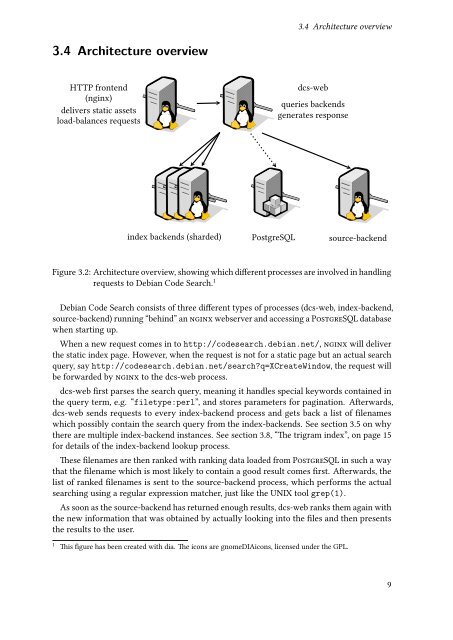Create successful ePaper yourself
Turn your PDF publications into a flip-book with our unique Google optimized e-Paper software.
3.4 Architecture overview<br />
HTTP frontend dcs-web<br />
(nginx)<br />
delivers static assets<br />
load-balances requests<br />
3.4 Architecture overview<br />
queries backends<br />
generates response<br />
index backends (sharded) PostgreSQL source-backend<br />
Figure 3.2: Architecture overview, showing which different processes are involved in handling<br />
requests to <strong>Debian</strong> <strong>Code</strong> <strong>Search</strong>. 1<br />
<strong>Debian</strong> <strong>Code</strong> <strong>Search</strong> consists of three different types of processes (dcs-web, index-backend,<br />
source-backend) running “behind” an nginx webserver and accessing a PostgreSQL database<br />
when starting up.<br />
When a new request comes in to http://codesearch.debian.net/, nginx will deliver<br />
the static index page. However, when the request is not for a static page but an actual search<br />
query, say http://codesearch.debian.net/search?q=XCreateWindow, the request will<br />
be forwarded by nginx to the dcs-web process.<br />
dcs-web first parses the search query, meaning it handles special keywords contained in<br />
the query term, e.g. “filetype:perl”, and stores parameters for pagination. Afterwards,<br />
dcs-web sends requests to every index-backend process and gets back a list of filenames<br />
which possibly contain the search query from the index-backends. See section 3.5 on why<br />
there are multiple index-backend instances. See section 3.8, “The trigram index”, on page 15<br />
for details of the index-backend lookup process.<br />
These filenames are then ranked with ranking data loaded from PostgreSQL in such a way<br />
that the filename which is most likely to contain a good result comes first. Afterwards, the<br />
list of ranked filenames is sent to the source-backend process, which performs the actual<br />
searching using a regular expression matcher, just like the UNIX tool grep(1).<br />
As soon as the source-backend has returned enough results, dcs-web ranks them again with<br />
the new information that was obtained by actually looking into the files and then presents<br />
the results to the user.<br />
1 This figure has been created with dia. The icons are gnomeDIAicons, licensed under the GPL.<br />
9


